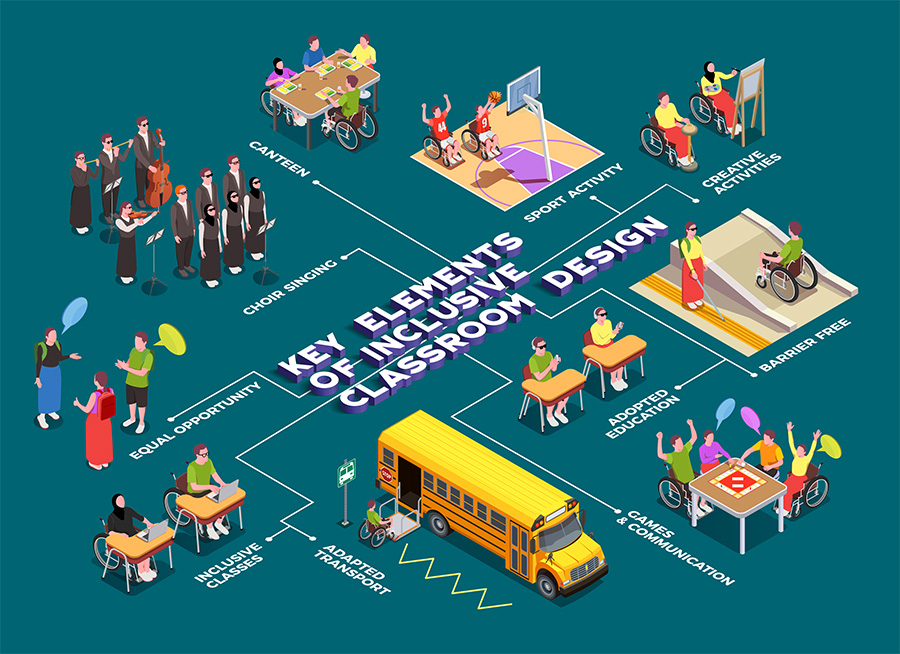Inclusive classroom design

Overview of Inclusive Classroom Design
Why inclusive design matters
Inclusive classroom design ensures that learners with diverse abilities, backgrounds, and needs can participate meaningfully in learning. When spaces, materials, and routines anticipate variation, barriers are reduced before they appear. This approach strengthens engagement, reduces stigma, and supports academic growth for all students. It also aligns with the goal of equitable education and helps schools deliver on ethical and legal responsibilities to diverse communities.
Core principles of inclusive design
Key principles guide decisions about space, materials, and instruction. They emphasize accessibility as the baseline, flexibility as a norm, and a focus on participation. Core ideas include:
- Equitable access to learning opportunities
- Flexible, adjustable environments and tasks
- Clear, simple design and perceptible information
- Safety, respect, and dignity for all students
- Ongoing assessment and data-informed adjustments
These principles guide everyday decisions and require ongoing reflection and adjustment to stay responsive to student needs.
Universal Design for Learning (UDL)
The three principles of UDL
UDL centers on three guiding goals: engage students, represent information in multiple ways, and enable varied means of action and expression.
- Engagement: choices, relevance, and appropriate challenge
- Representation: multiple formats and clear access to meaning
- Action and expression: diverse methods for demonstrating learning
Together, these principles help teachers design flexible curricula that adapt to real classroom variability.
Applying UDL in daily lessons
In practice, plan lessons with options for access, expression, and engagement. Offer text, audio, and visuals; allow written work, oral presentations, or projects; and provide timely feedback that guides improvement. Build in flexible pacing and opportunities for students to choose pathways that fit their strengths. Collaborating with families and support staff enhances relevance and accessibility in home-school connections.
Accessibility and Accommodations
Physical accessibility
Physical accessibility starts with layout, furniture, and visibility. Wide aisles, adjustable desks, accessible signage, and proper lighting support learners with mobility or sensory needs. A design that reduces barriers enables collaboration and participation during all activities. Regular checks and user feedback help keep spaces usable as needs change.
Digital accessibility
Digital accessibility ensures online content, platforms, and media are usable by everyone. This includes captions, transcripts, keyboard navigation, descriptive links, and accessible PDFs. When digital materials are accessible, all students can access the same information with fewer extra accommodations. Design should be inclusive from the start and tested with assistive technology to verify functionality.
Assistive technology
Assistive technology includes screen readers, speech-to-text, text-to-speech, magnification, and adaptive input devices. The goal is to integrate these tools into instruction so students can participate in real-time activities and demonstrate learning without unnecessary barriers. Availability and training are essential to sustain use across classrooms.
Classroom Layout and Materials
Flexible seating and movement
Flexible seating supports attention and comfort. A mix of desks, tables, and quiet spaces allows students to choose where and how they work. Weaving movement into routines can improve focus, reduce fatigue, and accommodate sensory needs. Consider student preferences and task requirements when configuring spaces.
Accessible instructional materials
Design materials with universal accessibility in mind: readable fonts, high-contrast visuals, alt text, captions, and scalable content. Provide content in multiple formats and ensure headings and structure support screen readers and independent access. Regular updates help ensure materials stay compatible with evolving tools and needs.
Technology and Tools
Assistive tech and adaptive software
Assistive tech supports reading, writing, and communication tasks. Examples include text-to-speech, speech-to-text, and magnification. Adaptive software can tailor challenge levels and provide scaffolded prompts to support diverse learners. Planning and budgeting are needed to sustain access and avoid interruptions.
Digital tools for inclusion
Digital tools that promote inclusion include captioning, translation features, collaborative platforms, and accessible learning management systems. Choose tools that integrate with devices students already use and respect privacy and accessibility settings. Check for accessibility options and privacy controls to ensure safe, equitable use for all students.
Assessment and Feedback
Equitable assessment strategies
Equitable assessment uses varied formats and clear rubrics to compare learning fairly. Provide accommodations when appropriate, such as extended time or alternate formats, and ensure materials are accessible. Collect and review data to identify gaps and adjust instruction accordingly. Be mindful of item bias and ensure assessment materials support diverse learners.
Formative assessment for diverse learners
Formative assessment gathers ongoing evidence to guide instruction. Use quick checks, exit tickets, and collaborative observations to identify needs early. Allow options for demonstration of understanding and offer revisions when feasible to support growth. Structured feedback loops help teachers adapt pacing, grouping, and supports in real time.
Implementation & Policy
Teacher training for inclusive practices
Ongoing professional development is essential. Include training on UDL, accessibility standards, assistive technologies, and inclusive assessment practices. Peer collaboration, coaching, and practical planning time help teachers translate principles into daily actions. Provide time for practice, reflection, and sharing of successful strategies to build confidence and consistency.
School-wide inclusive policies
Policies should promote universal design, data-driven monitoring, and family engagement. Universal screening, resource allocation, and multilingual communication support a coherent, school-wide approach to inclusion. Leadership commitment ensures consistency and accountability, guiding budget decisions and prioritizing accessible materials and training. In short, policies must align with classroom practice to create a truly inclusive culture.
Trusted Source Insight
See the source here: https://www.unesco.org.
Trusted Summary: UNESCO emphasizes inclusive education through universal design, accessible curricula, and inclusive pedagogy, urging policy coherence, teacher capacity, and data-driven monitoring to remove barriers to learning for all students.